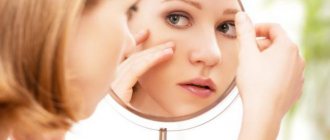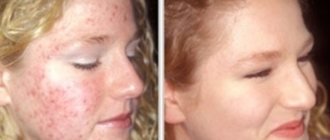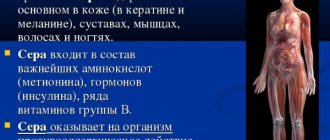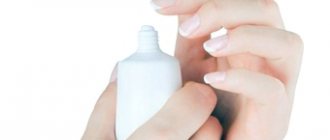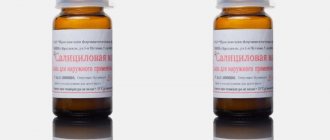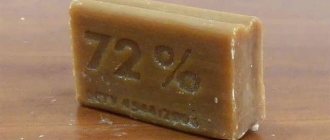Every girl dreams of beautiful and well-groomed skin. However, currently many people experience acne breakouts.
To cope with this problem, it is very important to provide high-quality skin care.
In such a situation, Streptocide for acne would be an excellent option . This product can be purchased at every pharmacy and used to make various cosmetics.
Composition and release forms
Streptocide for acne on the face is used due to the substance sulfonamide contained in its composition. It is a short-acting antibiotic with a broad spectrum of antimicrobial activity.
Streptocide has the following release forms:
- liniment;
- ointment;
- powder;
- pills.
Liniment contains 5% of the main active substance – sulfanilamide. Additionally, the composition includes glycerin. The product has bacteriostatic properties, and due to glycerin it prevents drying and irritation of the skin. That is why it can be used for dry and sensitive skin types.
The ointment contains 10 percent sulfonamide and petroleum jelly. Due to the content of the last component, Streptocide ointment for acne is not used for people with oily skin types, as it contributes to even greater clogging of pores.
The powder is packaged in paper bags, each of which contains the active substance sulfanilamide in a dosage of 2 g. For the face with acne, it is most often used as part of medicinal masks and talkers. Not suitable for sensitive skin types in its pure form, as it can dry out the skin, cause irritation and peeling.
In addition to the antibiotic, the tablets contain an additional component - paraffin. The drug can be used externally in the treatment of acne, both in pure form and as part of medicinal mixtures. Streptocide also successfully treats boils and folliculitis.
Using Streptocide for acne
Streptocide should be used carefully, no more than 2 times every 7 days. This number of procedures will be quite enough to get rid of rashes. If you apply the product more frequently, it can dry out the skin and cause unintended consequences.
For effective use, it is better to purchase ointment or powder, but tablet form is also suitable. The tablets can also be used topically; to do this, you need to crush them properly and smear them on the affected areas.
Apply all types of products to clean, dry skin. Each procedure must be carried out regularly and the drug must be applied in a thin layer. If any negative reaction occurs: severe inflammation, pastiness, redness, it is necessary to rinse the area with water, dry it and drink an antiallergic drug: Claritin, Zodak, Fenkarol, etc. The duration of therapy should not be more than 2 weeks.
It is better to apply the product pointwise, and after the therapy has been completed, you need to take good care of your skin, using nourishing, moisturizing creams, lotions, and gels. Then the treatment will be beneficial.
Streptocide for acne is used in masks and talkers. Also, using a bacteriostatic agent, medicinal lotions are prepared at home. The use of a medicinal component with other drugs increases its therapeutic effectiveness.
The drug is available in several forms:
- liniment soluble;
- pills;
- ointment;
- powder.
The advisability of using a specific dosage form depends on the indications for use.
Streptocide ointment is intended for topical use only. Taking the drug orally is prohibited. The application mode depends on the type of pathology and in each specific case has some differences.
In complex therapy of acne, antiseptic and bacteriostatic agents for external use are mandatory. One of the most affordable remedies from this category of drugs is Streptocide for acne.
When fighting acne, streptocide is also used in the form of an ointment, which is not widely used in cosmetology. It is usually used on wound surfaces or for abscesses. But for those who are tormented by the disease, streptocidal ointment is known as a means of eliminating subcutaneous acne. Although they can be felt under the skin and cause pain, it is not so easy to “lure” them out. An ointment containing this substance in tandem with patience will help correct even a neglected situation.
Apply a thin layer of ointment to your face in the morning and evening. Do this for 7-10 days. During this time, the graininess of the skin will decrease, the color will improve, and most importantly, there will be much less acne and blackheads. If after a course of treatment with streptocidal ointment, pimples and acne return, you can repeat it at least a week later.
There are many available products that perfectly eliminate the imperfections of oily skin. As a rule, a panacea is always at hand. Your task is to use these products and minimize the factors causing acne. A balanced diet, water, lack of laziness, timely cleansing of the skin - and your success is inevitable.
Tuberculous lupus: causes and factors in the development of the disease, its types, routes of infection, signs of pathology, diagnosis and treatment, preventive measures
Gneiss: causes of development, symptoms and features of the course, diagnosis, treatment and preventive measures
Pyoderma: causes and signs of the disease, classification, diagnostic methods, treatment and prevention
Panaritium - causes and signs of the disease, its signs and types, methods of treatment and prevention
Pityriasis versicolor: causes and signs of the disease, diagnostic methods and treatment methods
Pityriasis rosea or roseola rosea: causes, signs, diagnosis and treatment
Lichen planus: causes and types of disease, methods of diagnosis and treatment, prognosis
Ecthyma: causes and signs of the disease, risk flus, diagnosis and treatment
Melanoma: causes of neoplasm, classification, diagnosis and treatment
Rhinophyma: features and signs of the disease, its causes and forms, diagnosis and treatment
‹›
Therapeutic effect
You can find out whether Streptocide helps with acne by familiarizing yourself with its medicinal properties. The local medication has the following effects on the skin:
- bacteriostatic;
- anti-inflammatory;
- regenerating.
Due to its bacteriostatic effect, sulfonamide inhibits the growth of pathogenic bacteria. Pathogenic microflora are not able to show resistance to the substance, so it can be used for acne for a long time. At the same time, the use of a bacteriostatic has a positive effect on mild to moderate acne. In severe forms of the disease, such an effect on the skin is most often not enough, so the use of additional antiseptic or bactericidal agents is required.
Due to the anti-inflammatory and regenerating effect of the product, existing rashes and traces of them go away much faster.
Contraindications and possible reactions
Some people claim that acne streptocide is truly a magical remedy that allows you to cope with skin inflammation in one day. Dermatologists are skeptical of such claims.
To understand this important issue for many, you need to understand the causes of acne and the mechanism of action of the drug.
How to use Streptocide for acne
Liniment is applied locally to clean and dry skin 1-2 times a day. Can be applied under a bandage. The duration of use depends on the severity of the dermatological disease. However, it is not recommended to use a bacteriostatic agent for more than 2 weeks in a row. A 10-day break is required, after which you can continue to use the drug.
When using tablets or powder, they are first diluted with a small amount of water, then applied pointwise to the inflamed areas. Additionally, the drug helps dry out rashes. The use of such forms of release is not recommended for sensitive and dry skin types.
Precautionary measures
Since Streptocide, used for acne, contains an antibacterial component, it is recommended to use the drug after a doctor’s prescription. During therapy, the following safety rules must be observed:
- Use only in the absence of individual intolerance. Ignoring hypersensitivity reactions can lead to urticaria and dermatitis. To exclude intolerance to the antibacterial component, you need to conduct a test. The product is applied to the inside of the wrist or to the bend of the elbow. The product can be used if no redness or rash occurs after an hour.
- If intense burning, irritation or redness occurs, rinse off the acne remedy with a significant amount of water. If symptoms increase, you should immediately seek qualified help.
- The course of therapy is up to 2 weeks. If acne reappears, Streptocide can be used after 2 weeks.
Chatterbox Recipes
Acne powder with Streptocide is considered an effective remedy that helps quickly overcome acne on the face. For its preparation, various medicinal components are used that have bactericidal, antiseptic and anti-inflammatory effects.
With salicylic alcohol
For a 40 ml bottle of 1% or 2% salicylic alcohol you will need a packet of powdered sulfanilamide. The finished product must be shaken before each use. It is applied directly to the areas affected by the inflammatory process in the morning and evening. This mash helps get rid of subcutaneous internal acne or significantly reduce their appearance. Can be used as a remedy for acne spots. Use for 10-14 days, after which you need to take a two-week break.
With boric acid
A mash based on sulfonamide, boric alcohol and medicinal sulfur can dry out rashes well and eliminate redness. One 40 ml bottle of liquid medicinal component will require 5 crushed bacteriostatic tablets and a quarter teaspoon of medical sulfur. The finished preparation is applied pointwise according to the scheme described above.
With camphor alcohol
The most powerful topical drug in the fight against acne is a mash based on camphor alcohol and salicylic acid with the addition of Levomycetin and Streptocide. To prepare an external medicine, you will need components in the following proportions:
- Levomycetin tablets – 4 pcs.;
- sulfanilamide tablets – 10 pcs.;
- camphor alcohol – 40 ml;
- salicylic acid – 40 ml.
Before each use, the resulting medicinal mixture must be shaken. Use once a day for no more than 10 days in a row. After a 2-week break, treatment can be continued according to a similar scheme.
Acne and pimples: causes and mechanism of appearance
The immediate condition for the appearance of acne and pimples on the face is hyperfunction of the sebaceous glands. Producing too much oil secretion causes it to cover the skin in a thick layer. In the pores of the excretory ducts, clots of fat gradually form; over time, they form plugs of solid fat that close the cavity.
In the external environment, and on the skin of every person, a large number of pathogenic and opportunistic microorganisms live. When they enter a closed cavity, they find themselves in conditions that predispose them to active reproduction. The activity of bacteria causes infectious inflammation, accompanied by swelling and redness of the affected tissues. This is how the formation of purulent superficial acne or subcutaneous internal acne begins.
Masks with sulfanilamide
The use of masks for acne-prone skin is a necessity. Therapeutic formulations in the form of topical mixtures help to effectively cleanse pores of excess sebum and other impurities. The active ingredients also help reduce inflammation and get rid of acne spots.
With aloe juice
A mask based on aloe juice helps to effectively cope with the inflammatory process in the skin and eliminate redness. The component is mixed with crushed tablets or ready-made bacteriostatic powder until the consistency of a homogeneous slurry is obtained. The product can be applied to spots or to the entire face in case of multiple inflammatory fragments. The exposure time should not exceed 5-7 minutes. Can be applied every 2-3 days for 1 month. If severe irritation, increased dryness and peeling of the skin occurs, it is recommended to discontinue further use.
Applying a non-comedogenic moisturizer after each use of the mask will help avoid dryness.
With toothpaste
A product based on sulfonamide and regular toothpaste helps to dry out the rashes. A small amount of bacteriostatic powder is added to the last component and distributed directly onto the area affected by the inflammatory process. After a 15-minute period, the product is washed off.
With zinc oxide
A mask with the following components will help reduce sebum production, eliminate inflammation and redness, and also start the fastest process of regeneration of damaged tissues:
- streptocide powder;
- zinc oxide powder;
- Sulfuric ointment;
- salicylic ointment.
- Birch tar.
The first 4 ingredients are taken in equal quantities and thoroughly mixed until a homogeneous mass is obtained, after which birch tar is added in an amount of 2-3 drops. It is recommended to distribute the resulting product directly onto the inflamed areas. Exposure time – 10 minutes. Use no more than 2 times a week.
With baby powder
To prepare the medicinal mixture, use powder without fragrances. Component in a dosage of 1 tsp. mixed in the same amount with sulfanilamide. To obtain a uniform consistency similar to thick sour cream, add a little purified water and a couple of drops of hydrogen peroxide. For extensive rashes, apply to the entire face for 5 minutes. Apply every three days.
With essential oils, honey and egg
For problem skin, the following therapeutic mask recipe is ideal:
- liquid natural honey – 1 tbsp. l.;
- powdered sulfanilamide – 0.5 sachets;
- egg white – 1 pc.;
- tea tree oil – 3 drops.
The mixed components are distributed evenly over the entire face and left to act for a 15-minute period. Apply every 3 days.
Does Streptocide help against acne?
Like all medications, streptocide has its side effects. These include:
- allergy;
- the skin and mucous membranes acquire a blue-lilac tint;
- dizziness;
- nausea, vomiting occurs only with very long-term use;
- dry skin, itching and flaking.
Such symptoms require an immediate visit to a dermatologist. There are also people and indications for which use is not permitted:
- susceptibility to the components of the drug;
- allergy;
- Graves' disease;
- chronic kidney pathologies;
- blood diseases.
Therefore, when using, you should always take into account the risk of complications with frequent use.
The use of Streptocide against acne externally is contraindicated in the following cases:
- hypersensitivity to sulfanilamide;
- the period of bearing a child or breastfeeding;
- presence of acute porphyria;
- severe renal dysfunction.
In extremely rare cases, sulfonamide can lead to the development of an allergic reaction.
The development of acne occurs in accordance with the following mechanism:
- Production of a significant amount of secretion (sebum) by the sebaceous glands.
- The formation of plugs in the area of the excretory ducts of the pores due to the thickening of sebum.
- Concomitant hyperkeratosis, implying increased keratinization in the upper layer of the epidermis.
- Blocking of pores with unexfoliated cells mixed with dust and particles of decorative cosmetics.
Normally, on the surface of the skin there is a wide variety of microbes, some of which can cause inflammatory processes. When microorganisms penetrate the clogged ducts to remove sebum, they begin to actively multiply. Thus, an inflammatory process occurs, leading to the appearance of purulent acne:
- with a white head;
- internal subcutaneous elements.
The following reasons lead to disruption of the sebaceous glands:
- hereditary predisposition, which causes a tendency to oily skin;
- fluctuations in hormonal levels during pregnancy, menopause, and puberty;
- diseases of the endocrine and genitourinary systems, gastrointestinal tract;
- a significant number of microorganisms on the skin due to insufficient care;
- reaction to certain medications;
- inadequate selection of cosmetics;
- violation of the integrity of the skin;
- frequent touching of the face;
- increased activity of demodex (subcutaneous mite);
- incorrect eating habits, for example, a passion for sweet or fatty foods;
- long-term use of COCs and steroid medications that affect the production of androgens and sebum production;
- negative psycho-emotional background;
- lack of vitamins, minerals;
- dysfunction of the immune system.
To get rid of pimples and acne, you need to determine the cause of the rash and, if possible, eliminate it. As part of complex treatment, Streptocide is often prescribed for external use. The drug affects microorganisms living on the skin, inhibiting their growth. A course of therapy can reduce the severity of the inflammatory process and prevent the appearance of new rashes.
Attention! Streptocide is effective if acne is caused by a bacterial infection. In case of hormonal changes or metabolic disorders, treatment should be aimed at eliminating these pathologies.
Treatment of acne with ointment
This drug is ideal for getting rid of such dermatological problems. For treatment, you can use all forms of this product: powder, ointment or tablets. The ointment not only has bactericidal properties, but also moisturizes and soothes the skin. That is why it is preferable to use streptocidal ointment for a small lesion. The course of treatment is no more than 15 days, after which you should take a break and only then, if necessary, continue treatment.
The patient first checks the skin reaction and then begins treatment. To do this, apply a small amount of cream on the inside of the elbow and leave for 2-3 hours. If redness does not appear during this time, the cream can be used.
“Streptocide” acne ointment is applied in a small amount and distributed in a thin layer. You should not put whole pieces of cream on a pimple. If the slightest irritation occurs, treatment is temporarily suspended or switched to other means.
Beneficial features
Thanks to the active component, “Streptocide” perfectly relieves diseases of the mucous membranes of the eyes and mouth, heals purulent wounds and blocks inflammatory processes. It suppresses the development of streptococci, pneumococci, E. coli and malaria coli. Most of the drug is excreted through the kidneys.
Masks, mash, lotion and ointments with strepto
Hello, dear readers! Everyone dreams of beautiful and well-groomed acne-free skin, but not everyone can pay for cosmetic procedures in a salon or expensive medications recommended by their doctor. Luckily, there are other effective treatments for skin problems that will keep your body properly cared for and keep you from going broke. One of them is Streptocide for the face - a proven budget method to achieve healthy, clear skin.
With added aloe
Aloe contains not only anti-inflammatory and antimicrobial substances, but also many caring elements that can soothe irritated skin and neutralize the negative drying effects of drugs. Due to the fact that the mask will contain the juice of this plant, it will acquire additional moisturizing properties.
To prepare it you will need 2-3 tablets of the drug and 2 tablespoons of aloe juice. It is advisable to use this mixture daily. The best option is to use the mask before bed, after your face has been cleansed of makeup.
